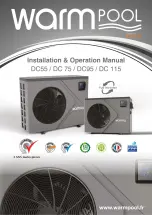
Manual 2100-602A
Page
34 of 41
SEQUENCE OF OPERATION
Cooling
– Circuit R-Y makes the thermostat pull in
the compressor contactor starting the compressor
and outdoor motor. The G (indoor motor) circuit
is automatically completed on any call for cooling
operation, or can be energized by manual fan switch on
subbase for constant air circulation.
Heating
– Circuit is completed for R-W1 on each
heating “on” cycle, energizing the electric heat contactor.
R-G also makes starting indoor blower motor.
Second stage heat – Energized circuit R-W2 and the
electric heat contactor for the second bank of heaters (if
equipped) is energized.
High / Low Pressure control
provides protection for
the compressor. In the event system pressures go
above 600 PSI or below 40 PSI in cooling mode the
compressor will be stopped. This will activate the
red light located in the control panel. The lockout
circuit will hold compressor off line. When the system
problem is corrected, the unit operation can be restored
by turning of the main power supply off and then back
on, or reset the room thermostat. The low pressure
control has a bypass to eliminate nuisance lockout on
cold start up. Factory set to 2 minutes.
Dehumidification / Reheat Circuit
– Both cooling and
heating take precedence over dehumidification.
Reheat Circuit
– There is a small capillary tube
inserted between the reheat coil return line and suction
line that will prevent liquid from accumulating in the
reheat coil when it is inactive. This drain does not
affect the normal operation of the system.
There is a check valve located in the reheat coil return
line. It has a soft spring to hold the ball on the seat.
This will make the method of checking the ball freedom
with a magnet difficult. Refer to Figures 24 and 25 for
the location of the check valve and drain back capillary.
When the system is operating in the dehumidification mode
the suction pressure will be reduced by 4 to 8 psig and the
discharge pressure will be reduced by 19 to 22 psig.
CRV / QERV OPERATION
QERV is energized by applying 24 VAC to the “F”
terminal of the low voltage terminal strip on units
with “X” climate control option. It is energized by the
“A” terminal of the thermostat on units with “E, J or
K” climate control option. On climate option “I” it is
energized by the brown/white wire at the CO
2
controller.
PRESSURE SERVICE PORTS
High and low pressure service ports are installed on
all units so that the system operating pressures can be
observed. Pressure curves can be found later in the
manual covering all models on both cooling and heating
cycles. It is imperative to match the correct pressure
curve to the unit by model number. Upper and lower
service doors must be attached to obtain proper reading.
FIGURE 23
CO
2
CONTROLLER – FACTORY SET TO 1000 PPM
PRESS UP AND DOWN
ARROWS TO ENTER
CONFIGURATION MODE
USE ARROWS TO SELECT
SETTING. PUSH MIDDLE
BUTTON TO CHANGE.
CONTROLLER WILL
SHOW SET.
NOTE: MENU
JUMPER MUST
BE SET TO "ON"
TO CHANGE ANY
SETTINGS WITH
THE FRONT BUTTONS.
TO LOCK THE CO2
CONTROLLER MOVE
JUMPER TO "OFF" AFTER
IT HAS BEEN CONFIGURED
Settings Recommended
Default
RON
1000
1000
ROF
950
950
DSP
C
CT
UNI
US
US
COL
Not Used
COH
Not Used
TOL
Not Used
TOH
Not Used
BAR See Instrution with Controller
For High Altitude Installations
CAL
Used for Field Calibration
MIS-3326
Summary of Contents for Q24A2DA
Page 7: ...Manual 2100 602A Page 7 of 41 FIGURE 1 UNIT DIMENSIONS...
Page 32: ...Manual 2100 602A Page 32 of 41 FIGURE 21 FRESH AIR DAMPER REMOVAL MOUNTING SCREW...
Page 35: ...Manual 2100 602A Page 35 of 41 FIGURE 24 AIR CONDITIONING MODE CIRCUIT DIAGRAM...
Page 36: ...Manual 2100 602A Page 36 of 41 FIGURE 25 DEHUMIDIFICATION MODE CIRCUIT DIAGRAM...








































